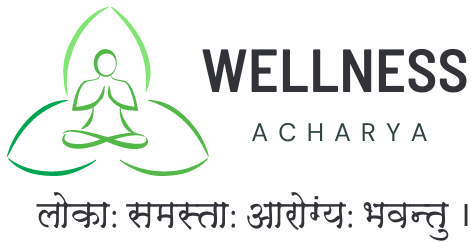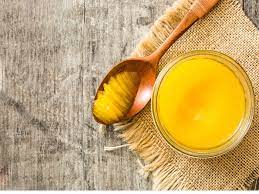Method of ghee preparation – whole milk bilona vs milk cream ghee
The dairy “ghee” commonly available in the open market is not made as per Ayurvedic procedure. It is made from milk cream, and not whole milk. As a result, it ends up being isolated milk fat, and can potentially cause increase in cholesterol. The ancient Ayurvedic bilona method of preparing ghee involves churning the curd of Gaumata’s whole milk. The butter thus obtained is heated on a slow flame to obtain ghee. Thus, ghee is the core essence of Gomata’s milk, offering a multitude of nutritional and medicinal benefits.
In this method, approximately 25 litres of milk is required to obtain 1 kg of ghee. The smell and consistency of this ghee may also vary based on season and feed.
Gomata Breed – Bharatiya vs Western
Practically, Gomata breed makes a huge difference to the quality of ghee in our view. Western breed Gomata’s such as Jersey and Holstein are genetically predisposed to fall sick in Bharatiya weather conditions. They are also heavily genetically modified. This makes their products far inferior in quality compared to products of pure Bharatiya breeds. We believe that it is important to look for pure breeds, and avoid cross breeds between Bharatiya and Western breeds. We also believe that increase in illnesses due to consumption of dairy in modern times is mainly caused due to Bharatiya society moving away from pure Bharatiya breeds and ‘animal husbandry’ approach replacing the traditional vedic gopalan approach.
How is Gomata cared for – Traditional gopalan vs Modern approach
There are vital differences between how Gomata is cared for between the paramparic (traditional) gopalan approach and the modern ‘animal husbandary’ approach. Under the vedic or paramparic approach, Gomata’s can generally be far healthier and happier. As a result, the products of Gomata who is looked after under the ‘Paramparic Gopalan’ approach are generally far superior when compared to products produced under the modern ‘animal husbandry approach’. Please see the following para’s and table for more detailed explaination of traditional gopalan and its comparison to modern approach.
What is paramparic gopalan?
The physical and subtle qualities of Ghee are affected by the following considerations, which are part of ancient vedic traditional approach to gopalan –
a) Ahinsak, adhering to ‘dohan’ – This ghee adheres to the ancient Bharatiya practice of “Dohan”. According to Shastra’s (ancient Bharatiya treatises), dohan (derived from “do” meaning two) literally means the calf is allowed to feed to its satisfaction from two Anchals, while the remaining two Anchals can be used to obtain milk for other living beings including humans. As a result, keeping other variables constant, milk availability can be lower at our Gaushala.
b) Gopalan that is non-exploitative
c) Gopalan that is consistent with principles of nature – Gomata’s should be bred and reared unrestricted in accordance with principles of nature, and graze in an organic field. Modern artificial interventions for breeding or to increase milk production should not be used. Gomata’s should not be tied up for long hours.
d) Organic feed . The feed must be also non-GMO and as far as possible organic. Pest control practices should must be strictly natural or organic.
e) Harnessing Ayurveda – Various Ayurvedic herbs of rich medicinal value are added to the feed based on weather and season to enhance Gomata’s health and vitality. As far as possible, sick Gomata’s are treated using Bharatiya Ayurvedic system and modern medicine is employed very occasionally.
f) Vedic rituals and music – Vedic havans (sacrificial fire ritual) should be done to maintain the sanctity of divine atmosphere of Gaushala. Devotional music and Sanskrit chants should also be played in the background every day, which helps to keep the Gomata’s happy and healthy.
But, how does one identify the purity of ghee? Here are some tips:—–
- If the ghee has solidified, spoon a small amount on your palm. It should begin to melt immediately with exposure to your body temperature. If it doesn’t, it likely has some hydrogenated vegetable fats added to it.
- Heat the ghee in a pan. In just a few seconds, the ghee must reach smoking point and change color to brown. If it remains yellow, it is impure.
- Add a little melted ghee in a glass jar with a plastic lid. Add a little sugar (about ½ a teaspoon sugar to 2 teaspoons melted ghee) to the jar and shake well to mix. Let this stand for 5-10 minutes. If you notice a red sediment in the jar, it means that the ghee is adulterated.

